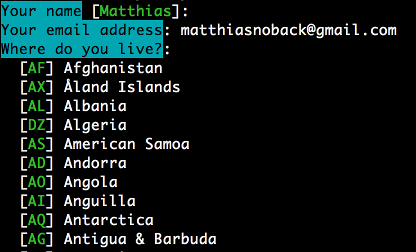matthiasnoback / symfony-console-form
Use Symfony forms for Console command input
Installs: 247 594
Dependents: 7
Suggesters: 1
Security: 0
Stars: 367
Watchers: 15
Forks: 24
Open Issues: 7
Requires
- php: >=8.0
- symfony/console: ~5.4 || ~6.0 || ~7.0
- symfony/form: ~5.4 || ~6.0 || ~7.0
- symfony/translation: ~5.4 || ~6.0 || ~7.0
Requires (Dev)
- beberlei/assert: ~2.1
- behat/behat: ^3.6
- phpunit/phpunit: ^9.5
- symfony/finder: ~5.4 || ~6.0 || ~7.0
- symfony/framework-bundle: ~5.4 || ~6.0 || ~7.0
- symfony/intl: ~5.4 || ~6.0 || ~7.0
- symfony/security-csrf: ~5.4 || ~6.0 || ~7.0
- symfony/validator: ~5.4 || ~6.0 || ~7.0
- symfony/yaml: ~5.4 || ~6.0 || ~7.0
- symplify/coding-standard: ^9.4
- symplify/easy-coding-standard: ^9.4
- dev-master
- v6.0.0
- v5.3.2
- v5.3.1
- v5.3.0
- v5.2.1
- v5.2.0
- v5.1.2
- v5.1.1
- v5.1.0
- v5.0.0
- v4.1.0
- v4.0.0
- v3.6.0
- v3.5.0
- v3.4
- v3.3.0
- v3.2.0
- v3.1.0
- v3.0.0
- v2.5.0
- v2.4.0
- v2.3.0
- v2.2.0
- v2.1.0
- v2.0.2
- v2.0.1
- v2.0.0
- v1.x-dev
- v1.2.0
- v1.1.2
- v1.1.1
- v1.1.0
- v1.0.2
- v1.0.1
- v1.0.0
- dev-fix_demo
- dev-add_test
- dev-cristoforocervino-master
- dev-fix
- dev-upgrade
- dev-fix_default_style
- dev-Guite-master
- dev-Jeroeny-symfony-5
This package is auto-updated.
Last update: 2025-01-24 10:03:59 UTC
README
By Matthias Noback
This package contains a Symfony bundle and some tools which enable you to use Symfony Form types to define and interactively process user input from the CLI.
Installation
composer require matthiasnoback/symfony-console-form
Enable Matthias\SymfonyConsoleForm\Bundle\SymfonyConsoleFormBundle in the kernel of your Symfony application.
<?php // app/AppKernel.php public function registerBundles() { $bundles = array( // ... new Matthias\SymfonyConsoleForm\Bundle\SymfonyConsoleFormBundle(), ); }
Usage
Follow the steps below or just clone this project, then run:
php test/console.php form:demo
Set up the form
<?php use Symfony\Component\Form\AbstractType; use Symfony\Component\Form\FormBuilderInterface; use Symfony\Component\OptionsResolver\OptionsResolverInterface; use Symfony\Component\Validator\Constraints\Country; use Symfony\Component\Validator\Constraints\Email; class DemoType extends AbstractType { public function buildForm(FormBuilderInterface $builder, array $options) { $builder ->add( 'name', 'text', [ 'label' => 'Your name', 'required' => true, 'data' => 'Matthias' ] ) ... ; } public function setDefaultOptions(OptionsResolverInterface $resolver) { $resolver->setDefaults(['data_class' => 'Matthias\SymfonyConsoleForm\Tests\Data\Demo']); } public function getName() { return 'test'; } }
The corresponding Demo class looks like this:
<?php class Demo { public $name; ... }
Create the console command; use the form helper
<?php use Symfony\Component\Console\Command\Command; use Symfony\Component\Console\Input\InputInterface; use Symfony\Component\Console\Output\OutputInterface; use Matthias\SymfonyConsoleForm\Console\Helper\FormHelper; class TestCommand extends Command { protected function configure() { $this->setName('form:demo'); } protected function execute(InputInterface $input, OutputInterface $output) { $formHelper = $this->getHelper('form'); /** @var FormHelper $formHelper */ $formData = $formHelper->interactUsingForm(DemoType::class, $input, $output); // $formData is the valid and populated form data object/array ... } }
When you provide command-line options with the names of the form fields, those values will be used as default values.
If you add the --no-interaction option when running the command, it will submit the form using the input options you provided.
If the submitted data is invalid the command will fail.
Using simpler forms with custom names
<?php use Symfony\Component\Console\Command\Command; use Symfony\Component\Console\Input\InputInterface; use Symfony\Component\Console\Input\InputOption; use Symfony\Component\Console\Output\OutputInterface; use Symfony\Component\Form\Extension\Core\Type\ChoiceType; use Matthias\SymfonyConsoleForm\Console\Helper\FormHelper; class TestCommand extends Command { protected function configure() { $this->setName('form:demo'); $this->addOption('custom-option', null, InputOption::VALUE_OPTIONAL, 'Your custom option', 'option1') } protected function execute(InputInterface $input, OutputInterface $output) { $formHelper = $this->getHelper('form'); /** @var FormHelper $formHelper */ $formData = $formHelper->interactUsingNamedForm('custom-option', ChoiceType::class, $input, $output, [ 'label' => 'Your label', 'help' => 'Additional information to help the interaction', 'choices' => [ 'Default value label' => 'option1', 'Another value Label' => 'option2', ] ]); // $formData will be "option1" or "option2" and option "--custom-option" will be used as default value ... } }
Nested Forms
If you have a complex compound form, you can define options and reference form children using square brackets:
<?php use Symfony\Component\Console\Command\Command; use Symfony\Component\Console\Input\InputInterface; use Symfony\Component\Console\Output\OutputInterface; use Matthias\SymfonyConsoleForm\Console\Helper\FormHelper; class TestCommand extends Command { protected function configure() { $this ->addOption('user[username]', null, InputOption::VALUE_OPTIONAL) ->addOption('user[email]', null, InputOption::VALUE_OPTIONAL) ->addOption('user[address][street]', null, InputOption::VALUE_OPTIONAL) ->addOption('user[address][city]', null, InputOption::VALUE_OPTIONAL) ->addOption('acceptTerms', null, InputOption::VALUE_OPTIONAL) ; } ... }
TODO
- Maybe: provide a way to submit a form at once, possibly using a JSON-encoded array
- Add more functional tests
- Show form label of root form
- Show nesting in form hierarchy using breadcrumbs
- When these things have been provided, release this as a package (or multiple packages for stand-alone use)

